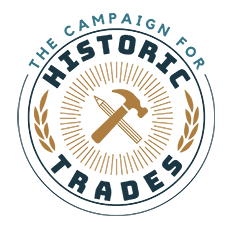Trades Curriculum and Trades Library
Stay Tuned!
The Campaign is developing open education resources for anyone to use and access freely. This is a long and involved process as we work with Subject Matter Experts and pilot testers to create national standards.
Want to stay updated on the process? Sign up for the newsletter for the latest updates.
Why Open Education Resources?
The Campaign is committed to overcoming systemic barriers to historic trades training. This includes access to educational resources, both for students and for programs.
Programs need instructional curriculum. Designing this, however, is time and resource intensive. It requires background research, input and knowledge from Subject Matter Experts, copyrighted or public domain learning and demonstrative media, and compliance with Section 508, which details how to make web-based information accessible to people with a variety of needs.
These access barriers are a fundamental hurdle in the creation and proliferation of historic trades training. It stymies programs’ abilities to provide instruction, thereby limiting student and public access to this vital information. By creating and sharing these resources, The Campaign hopes to help reduce the burden placed on individual programs and free their time to focus on training the next generation of historic tradespeople.
How do we get there?
The Campaign has a dedicated team to producing historic trades curriculum. We’re accomplishing it through the following steps:
- Copyright all work under a Creative Commons License.
This will allow people to use the curriculum in their programs, protect the content from copyright poaching, and require edits of the content to be licensed the same. Read more about our Creative Commons Attribution-NonCommercial-ShareAlike 4.0 International (CC BY-NC-SA 4.0) here. - Make the curriculum compliant with Section 508.
Section 508 is part of the Rehabilitation Act and requires that the government ensure internet-based resources can be used independently by anyone. For publicly-funded institutions, this is a requirement. For privately-funded institutions, these are best practices make sure your work is inclusive and accessible. Ensuring compliance requires time and learning about the regulations. By creating curriculum with these requirements at the forefront, anyone who uses and instructs with the material can meet these best practices and requirements. Read more about Section 508. - Produce curriculum in English and Spanish.
The United States has the second largest population of Spanish speakers in the world, with over 41 million native Spanish speakers. About half of those speakers (or 8% of the US population) have limited-English proficiency. The number of US-based Spanish speakers is expected to triple by the year 2050. Considering that nearly a third of construction workers identify as Hispanic and/or Latinx, bilingual training resources are the only way to move forward in curriculum development. We are working to retroactively translate English resources into Spanish and create all new curriculum bilingually with our partners at CENCOR. Read more about our work and partnership here. - Create a variety media resources.
People learn in different ways, and programs have individual needs. As such, we will produce text-based, video, audio, photographs, drawings, and interactive coursework with learning objectives anchoring these resources to our national standards. This will provide the needed consistency for teaching national standards, as well as provide programs and people with selective needs.
There are many ways for individuals, businesses, organizations, and philanthropic groups to support The Campaign. Find out how.
